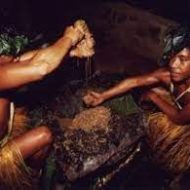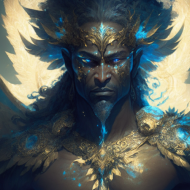Isokelekel : The Founding Father
Listen
At a glance
| Description | |
|---|---|
| Origin | Micronesian Mythology |
| Classification | Mortals |
| Family Members | N/A |
| Region | Kosrae, Pohnpei |
| Associated With | Founding country, Warfare |
Isokelekel
Introduction
The mythical hero Idzikolkol, also known as Isokelekel, was from Kosrae and defeated the Saudeleur Dynasty at Pohnpei. He is regarded as the father of the modern island nation. There are varying sources about the events that occurred before and during the attack on Pohnpei, and 13 different accounts have been published.
In most of the stories, the collapse of the dynasty was caused by the oppression of its ruling class, which was exacerbated by the mistreatment of Nan Sapwe by its lords. The culture of Pohnpei is decentralized and autonomous, and quibbling publicly over variations is regarded as bad form.
Various cultural phenomena such as clan affiliation and the kava social groups contribute to the varying accounts. Because of this, any preferred variant is typically the product of autonomy and self-interest. The modern inhabitants of Pohnpei are the descendants of the people who traveled to the island with the expeditionary party of the legend’s hero, Idzikolkel.
Physical Traits
Isokelekel is often described as a strong and well built man wearing the traditional garb of the islands.
Family
One of the most common stories about Isokelekel’s birth is that he is the offspring of Nan Sapwe, who was an ill-tempered and rebellious Thunder God. The Saudeleur’s fury was directed toward Nan Sapwe after she had been unfaithful to the ruler’s wife. Other stories claim that the ruler insulted a high priest who predicted the downfall of the dynasty and that he also incensed other gods.
Following the Saudeleur’s oppression, Nan Sapwe left Pohnpei and traveled to Kosrae. Some believe that the Thunder God fled to East Katau. He impregnated a member of his own tribe, who was known as Lipahnmei, by giving her a lime. This union resulted in the birth of Isokelekel, who knew his fate.
Other names
Isokelekel also means “shining noble” or “wonderful king” and he was also called Idzikolkol
Powers and Abilities
When he was a young adult, over 300 individuals, including women, children, and men, embarked on a journey to conquer Pohnpei. The journey was conducted in a human sacrifice ceremony, which was rare in the history of the island nation. In the eastern Caroline Islands, which included the Mortlocks, Pingelap, and Ant Atoll, it is believed that Isokelekel made multiple stops along his way to Pohnpei. Some say that he learned about his mission to conquer the island by gathering information from various sources, such as his mother or a bird.
The invaders’ canoe first made its way into Pohnpei through a channel near Kehpara. From Kitti, they headed toward the island. Upon reaching Palikir, they were offered leftover lihli, which was a gesture forbidden to high-ranking individuals. Pohnpei was given the name Sapwen luh Pohnpei, which literally means “Land of Leftovers.”
Modern Day Influence
He is known as a cultural hero in both Pohnpei and Kosrae. He has left a significant number of claimants of descent on the island, including several generations of reigning NAHNMwarki kings. Despite the existence of dual blood lines in the region, modern chiefs still trace their lineage back to him.
The use of the name Isokelekel to refer to a Pohnpeian is regarded as an undisguised challenge in the region. In 1995, Petersen noted that the concept of caution was associated with the myth of the king. He also states that the events that happened in the history of Pohnpei were initiated by outsiders.
Related Images
Sources
Hanlon, D. L. (1988). Upon a Stone Altar: A History of the Island of Pohnpei to 1890. University of Hawaii Press.
Petersen, G. (1990). Lost in the Weeds: Theme and Variation in Pohnpei Political Mythology. Center for Pacific Islands Studies, University of Hawaiʻi at Mānoa.
Lessa, W. A. (1980). More Tales from Ulithi Atoll: A Content Analysis. University of California Press.
Wikipedia contributors. (n.d.). Isokelekel. Wikipedia. Retrieved May 14, 2025, from https://en.wikipedia.org/wiki/Isokelekel
Digital Pasifik. (2018, March 15). Legend of Isokelekel, Pohnpei. Retrieved May 14, 2025, from https://digitalpasifik.org/items/8314
Micronesica. (n.d.). The Saudeleur to Nahnmwarki Transformation. Retrieved May 14, 2025, from https://micronesica.org/sites/default/files/supp02-23ed.pdf
Frequently Asked Questions
Who was Isokelekel?
Isokelekel was a legendary warrior-hero from Micronesian mythology who led a rebellion against the oppressive Saudeleur dynasty in Pohnpei and established the Nahnmwarki system of rule.
Where did Isokelekel come from?
According to legend, he came from the island of Kosrae or a mythical eastern land, possibly with divine or supernatural origins.
Why is Isokelekel important in Micronesian history?
He is seen as a culture hero who freed Pohnpei from tyranny and reshaped its political system, laying the foundation for modern Pohnpeian society.
What powers or traits are associated with Isokelekel?
Isokelekel was known for his strength, charisma, and divine lineage—many legends attribute his success to spiritual guidance and destiny.
Is Isokelekel worshipped or honored today?
While not worshipped, Isokelekel is deeply respected and remembered in oral traditions, rituals, and cultural identity across Pohnpei.








